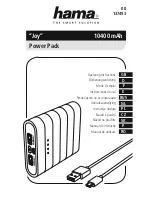
SNMP-NET
20
Glossary
Agent
Implemented SNMP applications in network elements (hosts). Agents perform the network
management’s functions as requested by the network administrator from an NMS.
Ethernet
Local Area Network technology, can link up to 1,024 nodes in a bus network. Ethernet
provides raw data transfer in a rate of 10 megabits/sec. with actual throughputs in 2 to 3
megabits/sec. using a base-band (single-channel) communication technique. Ethernet uses
carrier sense multiple access collision detection (CSMA/CD) that prevents network failures
when two devices attempt to access the network at the same time. LAN hardware manufactures
use Ethernet protocol; their products may not be compatible.
Gateway
A device that attaches to a number of networks and routes packets between them. The
packets can be different protocols at the higher levels.
IP
Internet Protocol
—
The TCP/IP standard protocol defines the IP datagram as the unit of
information passed across a network.
IP Address
Internet Protocol Address
—
A 32-bit address assigned to hosts participating in a TCP/IP
network. The IP address consists of network and host portions. It is assigned to an
interconnection of a host to a physical network.
MAC
Medium Access Control
—
The network layer between the physical and the data link layers.
Specifically, the physical (hardware) address exists in this layer.
MIB
Management Information Base
—
The database, i.e., set of variables maintained by a gateway
running SNMP.
NMS
Network Management Station
—
A combination of hardware and software used to monitor and
administer a network.
OID
Object Identifier
—
The variables defined in a MIB.
Router
A device that manages traffic between different network segments or different network
topologies. It directs the destination IP address. The network media can be different, but the
higher-level protocols must be the same.
SNMP
Simple Network Management Protocol
—
A standard protocol used to monitor IP hosts,
networks, and gateways. SNMP defines a set of simple operations that can be performed on the
OIDs of the MIBs managed by the monitored Agents. It employs the UDP/IP transport layer to
move its object between the Agents and the NMS.
Sub-Agent
A software module that manages specific MIB sub-groups for an Agent. They communicate
with the Agent using a SMUX (multiplexer).
TCP/IP
Transmission Control Protocol/Internet Protocol
—
A protocol suite used by more than 15
million users with a UNIX association and widely used to link computers of different kinds.
TFTP Server
Trivial File Transfer Protocol Server
—
A host to provide services according to TFTP; a TCP/IP
standard protocol for file transfer with minimal capability and overhead depending on UDP for its
datagram delivery service.
UDP/IP
User Datagram Protocol/Internet Protocol
—
A TCP/IP standard protocol. It enables transfer of
information between applications running on different host. It is referred to as an unreliable,
connectionless datagram delivery service.
UPS
Uninterruptible Power Supply
—
A battery backup device that supplies power to your system
when there is an AC power failure.



































